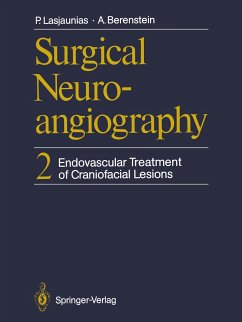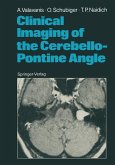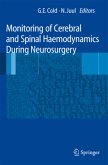Pierre Lasjaunias, Alejandro Berenstein
Surgical Neuroangiography
2 Endovascular Treatment of Craniofacial Lesions
Pierre Lasjaunias, Alejandro Berenstein
Surgical Neuroangiography
2 Endovascular Treatment of Craniofacial Lesions
- Broschiertes Buch
- Merkliste
- Auf die Merkliste
- Bewerten Bewerten
- Teilen
- Produkt teilen
- Produkterinnerung
- Produkterinnerung
Gives an account of clinical procedure. Based on the des- cription of the functional anatomy of the craniofacial arte- ries given in Volume 1. Treats technical aspects such as pa- tient preparation, technical equipment, embolic agent, and flow control as well as a description of the therapy for different kinds of tumors, fistulas, aneurysms, and vascular malformation.
Andere Kunden interessierten sich auch für
![Surgical Neuroangiography Surgical Neuroangiography]() Alejandro BerensteinSurgical Neuroangiography110,99 €
Alejandro BerensteinSurgical Neuroangiography110,99 €![Surgical Neuroangiography Surgical Neuroangiography]() Alejandro BerensteinSurgical Neuroangiography173,99 €
Alejandro BerensteinSurgical Neuroangiography173,99 €![Surgical Neuroangiography Surgical Neuroangiography]() P. LasjauniasSurgical Neuroangiography228,99 €
P. LasjauniasSurgical Neuroangiography228,99 €![Surgical Neuroangiography Surgical Neuroangiography]() P. LasjauniasSurgical Neuroangiography315,99 €
P. LasjauniasSurgical Neuroangiography315,99 €![Clinical Imaging of the Cerebello-Pontine Angle Clinical Imaging of the Cerebello-Pontine Angle]() Anton ValavanisClinical Imaging of the Cerebello-Pontine Angle81,99 €
Anton ValavanisClinical Imaging of the Cerebello-Pontine Angle81,99 €![Spinal Cord Monitoring Spinal Cord Monitoring]() Spinal Cord Monitoring81,99 €
Spinal Cord Monitoring81,99 €![Monitoring of Cerebral and Spinal Haemodynamics during Neurosurgery Monitoring of Cerebral and Spinal Haemodynamics during Neurosurgery]() Monitoring of Cerebral and Spinal Haemodynamics during Neurosurgery93,99 €
Monitoring of Cerebral and Spinal Haemodynamics during Neurosurgery93,99 €-
-
-
Gives an account of clinical procedure. Based on the des-
cription of the functional anatomy of the craniofacial arte-
ries given in Volume 1. Treats technical aspects such as pa-
tient preparation, technical equipment, embolic agent, and
flow control as well as a description of the therapy for
different kinds of tumors, fistulas, aneurysms, and vascular
malformation.
Hinweis: Dieser Artikel kann nur an eine deutsche Lieferadresse ausgeliefert werden.
cription of the functional anatomy of the craniofacial arte-
ries given in Volume 1. Treats technical aspects such as pa-
tient preparation, technical equipment, embolic agent, and
flow control as well as a description of the therapy for
different kinds of tumors, fistulas, aneurysms, and vascular
malformation.
Hinweis: Dieser Artikel kann nur an eine deutsche Lieferadresse ausgeliefert werden.
Produktdetails
- Produktdetails
- Verlag: Springer, Berlin
- Softcover reprint of the original 1st ed. 1987
- Seitenzahl: 452
- Erscheinungstermin: 17. November 2011
- Englisch
- Abmessung: 280mm x 210mm x 25mm
- Gewicht: 1092g
- ISBN-13: 9783642711909
- ISBN-10: 3642711901
- Artikelnr.: 36116474
- Herstellerkennzeichnung Die Herstellerinformationen sind derzeit nicht verfügbar.
- Verlag: Springer, Berlin
- Softcover reprint of the original 1st ed. 1987
- Seitenzahl: 452
- Erscheinungstermin: 17. November 2011
- Englisch
- Abmessung: 280mm x 210mm x 25mm
- Gewicht: 1092g
- ISBN-13: 9783642711909
- ISBN-10: 3642711901
- Artikelnr.: 36116474
- Herstellerkennzeichnung Die Herstellerinformationen sind derzeit nicht verfügbar.
1 Technical Aspects of Surgical Neuroangiography.- I. Introduction.- II. Patient Preparation.- Preoperative Medications.- III.Anesthesia of Embolization.- 1. General Anesthesia.- 2. Neuroleptic Analgesia.- 3. Tracheostomy.- 4. Local Anesthesia.- IV.Puncture Sites.- Introducer Sheath.- V. Catheters and Delivery Systems.- 1. Conventional Catheters.- 2. Balloon Catheters.- 3. Propelling Chambers.- 4. Detachable Balloons.- 5.Open End Guidewires.- 6.Guidewires.- VI. Embolic Agents.- 1. Particle Embolization.- 2.Gianturco Coils.- 3.Nonabsorbable Liquids.- VII. Opacifying Agents.- 1. Tantalum Powder.- 2. Metrizamide Powder.- VIII. Ethyl Alcohol (95 %Ethanol).- 1. Ethanol Injection in the Arterial System.- 2. Ethanol Injection in Venous Malformations.- IX. Infusion Chemotherapy.- Time Released Microcapsules (Chemoembolization).- X. Other Potential Agents.- 1. Ethibloc.- 2. Collagen.- 3. Estrogen.- XL Miscellaneous.- 1. Syringes.- 2. Stopcocks and "Y" Adaptors.- 3. Tray Containers.- 4. Flushing Solutions.- 5. Systemic Heparinization.- 6. Activated Coagulation Time (ACT) Monitoring.- 7. Corticosteroids.- 8. Normal Physiology of the External Carotid Arteries.- XII. FlowControl.- 1. Protection of a "Dangerous" Anastomosis.- 2. Intralesional Flow Control.- 3. Occlusive Balloon Flow Reversal.- 4. Functional Rearrangement of the Supply to a Territory.- 5. Surgical Flow Control.- XIII. Provocative Test.- XIV. Electrophysiological Monitoring (EPhM).- XV. Angiographic Equipment.- XVI. Postembolization Care.- XVII. SpecialCare.- 1. Neurological Deficit.- 2. Post-Op Swelling.- 3. Skin Necrosis.- XVIII. Follow-Up.- 2 Dural and Bony Tumors.- I. Introduction.- II. Meningiomas.- 1. Epidemiology.- 2. Pathology.- 3. Clinical Presentation.- 4. Pretherapeutic Evaluation.- 5. Therapeutic Strategy and Clinical Objectives.- 6. Technical Aspects of Embolization.- 7. Special Considerations in Meningioma Embolization.- III. Other Bony and Dural Tumors.- 1. Cerebral Tumors.- 2. Neurinomas.- 3. Esthesioneuroblastomas.- 3 Nasopharyngeal Tumors.- I. Juvenile Angiofibromas (JAF).- 1. Macroscopic Pathology.- 2. Microscopic Pathology.- 3. Epidemiology.- 4. Pathophysiology.- 5. Clinical Findings.- 6. Natural History.- 7. Pretherapeutic Evaluation.- 8. Therapeutic Goals.- 9. Technical Aspects of Embolization.- 10. Tumor Recurrence.- II. Other Nasopharyngeal Tumors.- III. Conclusion.- 4 Temporal and Cervical Tumors.- Branchial Paragangliomas.- 1. Introduction.- 2. Embryology.- 3. Epidemiology.- 4. Pathology.- 5. Natural History.- 6. Clinical Aspects.- 7. Differential Diagnosis.- 8. Pretherapeutic Evaluation.- 9. Therapeutic Strategies.- 10. Technical Aspects of Embolization.- 11. Complications of Embolization of Paragangliomas.- 5 Other Craniofacial Tumors.- I. ThyrolaryngealTumors.- II. Craniofacial Malignant Lesions.- 6 Arteriovenous Fistulas (AVFs).- I. Introduction.- II. Carotid Cavernous Fistulas (CCFs).- 1. Anatomo-Clinical Features.- 2. Etiology and Epidemiology.- 3. Natural History.- 4. Visual Symptoms.- 5. Pretherapeutic Evaluation.- 6. Therapeutic Objectives and Strategy.- 7. Technical Aspects of Embolization.- 8. Postembolization Care.- III.Vertebral Arteriovenous Fistulas (VAFs).- 1. General.- 2. Clinical Findings.- 3. Natural History and Indications for Treatment.- 4. Pretherapeutic Evaluation.- 5. Angiographic Protocol.- 6. Embolization.- IV.Common Carotid Fistulas (CCFs).- V. External Carotid Fistulas (ECFs).- 1. General.- 2. Incidence.- 3. Natural History.- VI. Other Types of AVFs.- 1. Fistulas of the External Carotid Main Trunk.- 2. Malignant Fistulas.- 7 Aneurysms.- I. Introduction.- II. Extradural Carotid Artery Aneurysms.- 1. General.- 2. Aneurysms of the Common Carotid Artery.- 3. Cervical Internal Carotid Aneurysms.- 4. Petrous Carotid Aneurysms.- 5. Aneurysms of the Cavernous Segment of the Internal Carotid Artery (ACCs).- III. Aneurysms of the External Carotid Artery.- IV. Extradural Vertebral Aneurysms.- V. Fibromuscular Dysplasia (FMD).- 1. Ge
1 Technical Aspects of Surgical Neuroangiography.- I. Introduction.- II. Patient Preparation.- Preoperative Medications.- III.Anesthesia of Embolization.- 1. General Anesthesia.- 2. Neuroleptic Analgesia.- 3. Tracheostomy.- 4. Local Anesthesia.- IV.Puncture Sites.- Introducer Sheath.- V. Catheters and Delivery Systems.- 1. Conventional Catheters.- 2. Balloon Catheters.- 3. Propelling Chambers.- 4. Detachable Balloons.- 5.Open End Guidewires.- 6.Guidewires.- VI. Embolic Agents.- 1. Particle Embolization.- 2.Gianturco Coils.- 3.Nonabsorbable Liquids.- VII. Opacifying Agents.- 1. Tantalum Powder.- 2. Metrizamide Powder.- VIII. Ethyl Alcohol (95 %Ethanol).- 1. Ethanol Injection in the Arterial System.- 2. Ethanol Injection in Venous Malformations.- IX. Infusion Chemotherapy.- Time Released Microcapsules (Chemoembolization).- X. Other Potential Agents.- 1. Ethibloc.- 2. Collagen.- 3. Estrogen.- XL Miscellaneous.- 1. Syringes.- 2. Stopcocks and "Y" Adaptors.- 3. Tray Containers.- 4. Flushing Solutions.- 5. Systemic Heparinization.- 6. Activated Coagulation Time (ACT) Monitoring.- 7. Corticosteroids.- 8. Normal Physiology of the External Carotid Arteries.- XII. FlowControl.- 1. Protection of a "Dangerous" Anastomosis.- 2. Intralesional Flow Control.- 3. Occlusive Balloon Flow Reversal.- 4. Functional Rearrangement of the Supply to a Territory.- 5. Surgical Flow Control.- XIII. Provocative Test.- XIV. Electrophysiological Monitoring (EPhM).- XV. Angiographic Equipment.- XVI. Postembolization Care.- XVII. SpecialCare.- 1. Neurological Deficit.- 2. Post-Op Swelling.- 3. Skin Necrosis.- XVIII. Follow-Up.- 2 Dural and Bony Tumors.- I. Introduction.- II. Meningiomas.- 1. Epidemiology.- 2. Pathology.- 3. Clinical Presentation.- 4. Pretherapeutic Evaluation.- 5. Therapeutic Strategy and Clinical Objectives.- 6. Technical Aspects of Embolization.- 7. Special Considerations in Meningioma Embolization.- III. Other Bony and Dural Tumors.- 1. Cerebral Tumors.- 2. Neurinomas.- 3. Esthesioneuroblastomas.- 3 Nasopharyngeal Tumors.- I. Juvenile Angiofibromas (JAF).- 1. Macroscopic Pathology.- 2. Microscopic Pathology.- 3. Epidemiology.- 4. Pathophysiology.- 5. Clinical Findings.- 6. Natural History.- 7. Pretherapeutic Evaluation.- 8. Therapeutic Goals.- 9. Technical Aspects of Embolization.- 10. Tumor Recurrence.- II. Other Nasopharyngeal Tumors.- III. Conclusion.- 4 Temporal and Cervical Tumors.- Branchial Paragangliomas.- 1. Introduction.- 2. Embryology.- 3. Epidemiology.- 4. Pathology.- 5. Natural History.- 6. Clinical Aspects.- 7. Differential Diagnosis.- 8. Pretherapeutic Evaluation.- 9. Therapeutic Strategies.- 10. Technical Aspects of Embolization.- 11. Complications of Embolization of Paragangliomas.- 5 Other Craniofacial Tumors.- I. ThyrolaryngealTumors.- II. Craniofacial Malignant Lesions.- 6 Arteriovenous Fistulas (AVFs).- I. Introduction.- II. Carotid Cavernous Fistulas (CCFs).- 1. Anatomo-Clinical Features.- 2. Etiology and Epidemiology.- 3. Natural History.- 4. Visual Symptoms.- 5. Pretherapeutic Evaluation.- 6. Therapeutic Objectives and Strategy.- 7. Technical Aspects of Embolization.- 8. Postembolization Care.- III.Vertebral Arteriovenous Fistulas (VAFs).- 1. General.- 2. Clinical Findings.- 3. Natural History and Indications for Treatment.- 4. Pretherapeutic Evaluation.- 5. Angiographic Protocol.- 6. Embolization.- IV.Common Carotid Fistulas (CCFs).- V. External Carotid Fistulas (ECFs).- 1. General.- 2. Incidence.- 3. Natural History.- VI. Other Types of AVFs.- 1. Fistulas of the External Carotid Main Trunk.- 2. Malignant Fistulas.- 7 Aneurysms.- I. Introduction.- II. Extradural Carotid Artery Aneurysms.- 1. General.- 2. Aneurysms of the Common Carotid Artery.- 3. Cervical Internal Carotid Aneurysms.- 4. Petrous Carotid Aneurysms.- 5. Aneurysms of the Cavernous Segment of the Internal Carotid Artery (ACCs).- III. Aneurysms of the External Carotid Artery.- IV. Extradural Vertebral Aneurysms.- V. Fibromuscular Dysplasia (FMD).- 1. Ge








